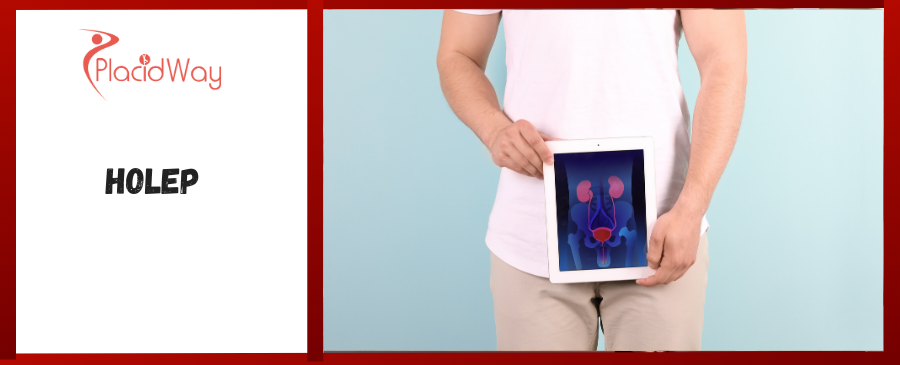
Reclaim Your Comfort: Understanding HoLEP for an Enlarged Prostate
If you’re a man over 50, you might be familiar with the frustrating and disruptive symptoms of an enlarged prostate, medically known as Benign Prostatic Hyperplasia (BPH). It's a condition that can significantly impact your quality of life, leading to frequent bathroom trips, a weak urine stream, and a constant feeling of incomplete emptying. These symptoms aren't just an inconvenience; they can disrupt sleep, affect travel plans, and even lead to more serious urinary issues if left untreated.
For many years, surgical options for BPH involved more invasive procedures with longer recovery times. However, medical science has advanced, offering highly effective, minimally invasive solutions like HoLEP (Holmium Laser Enucleation of the Prostate). This advanced laser surgery has emerged as a gold standard for treating enlarged prostates, especially for larger glands, providing excellent long-term results and a quicker return to daily activities.
Understanding HoLEP, from what it treats to what to expect during recovery and its cost implications, is crucial for anyone considering this life-changing procedure. This guide will walk you through everything you need to know, including why a growing number of patients are exploring HoLEP as a medical tourism option to find high-quality care at a more accessible price point.
What are the common symptoms of an enlarged prostate (BPH) that might lead to HoLEP?
Living with an enlarged prostate can feel like a constant battle with your bladder. The prostate gland, located just below the bladder, can press against the urethra when it grows, causing a range of uncomfortable and inconvenient urinary symptoms. Patients often search for "enlarged prostate symptoms" or "BPH symptoms" when trying to understand what's happening. These can include:
- Frequent urination: Needing to urinate more often than usual, both during the day and particularly at night (nocturia). This is often one of the most bothersome symptoms, constantly interrupting sleep and daily activities.
- Weak or interrupted urine stream: The flow of urine may be slow, hesitant, or stop and start.
- Difficulty starting urination (hesitancy): It can take an effort to begin the flow of urine.
- Dribbling at the end of urination: A few drops of urine may leak out after you think you're done.
- Feeling of incomplete bladder emptying: Even after urinating, you might feel like your bladder isn't completely empty.
- Urgency: A sudden, strong need to urinate that's hard to postpone.
- Urinary retention: In severe cases, the inability to urinate at all, which is a medical emergency.
If these symptoms are significantly impacting your life, seeking medical advice is the first step, and HoLEP might be a recommended solution.
What causes benign prostatic hyperplasia (BPH) and who is at risk?
BPH is an extremely common condition, affecting about half of men in their 50s and up to 90% of men in their 80s. While the exact "enlarged prostate causes" aren't fully understood, aging and hormonal changes, particularly relating to testosterone and estrogen levels, play a significant role. As men age, the cells in the prostate gland can begin to multiply, leading to its enlargement.
Beyond age, several factors can increase your risk:
- Family history: If your father or brother has BPH, you're more likely to develop it.
- Ethnicity: BPH is more common in Western men.
- Obesity: Being overweight can increase your risk.
- Heart disease and circulatory problems: Conditions affecting the heart and blood vessels are linked to a higher risk.
- Type 2 diabetes: Men with diabetes also have an increased risk of developing BPH.
It's important to remember that BPH is not prostate cancer, nor does it increase your risk of developing prostate cancer. However, the symptoms can be similar, so a thorough diagnosis from a urologist is essential.
How does HoLEP compare to other treatments for enlarged prostate?
When considering treatment for an enlarged prostate, patients often search for "HoLEP vs TURP" or "alternatives to HoLEP." While medications can manage mild symptoms, surgical intervention is often necessary for moderate to severe cases. Here's how HoLEP stands out:
- Transurethral Resection of the Prostate (TURP): For decades, TURP was the gold standard. It involves shaving away small pieces of prostate tissue. While effective, it can be associated with more bleeding, a longer hospital stay, and a higher chance of needing re-treatment compared to HoLEP, especially for larger prostates.
- HoLEP (Holmium Laser Enucleation of the Prostate): HoLEP uses a high-powered holmium laser to precisely remove the entire obstructing inner portion of the prostate gland, similar to how an orange peel is removed from an orange. The removed tissue is then safely morcellated (chopped) and suctioned out.
Key advantages of HoLEP:
- Suitable for any prostate size: Unlike TURP, HoLEP can effectively treat even very large prostates.
- Minimally invasive: Performed through the urethra, with no external incisions.
- Less bleeding: The laser seals blood vessels, reducing blood loss.
- Shorter hospital stay: Often 1-2 nights, compared to 2-3 for TURP.
- Faster recovery: Patients generally return to normal activities sooner.
- Durable results: Considered a definitive treatment with very low re-treatment rates.
- Tissue for pathology: The removed tissue can be analyzed for cancer, if needed.
Other newer procedures like UroLift and Rez?m are also available, but these often treat smaller prostates and may not offer the same comprehensive tissue removal as HoLEP, making HoLEP a strong choice for those seeking a one-time, highly effective solution.
Who is an ideal candidate for HoLEP surgery?
If you're wondering, "Am I a candidate for HoLEP?", your urologist will evaluate several factors. HoLEP is particularly well-suited for:
- Men with significant BPH symptoms that have not improved with medication or lifestyle changes.
- Patients with larger prostates (typically over 60 grams), where other procedures might be less effective or carry higher risks. However, HoLEP is effective for all prostate sizes.
- Individuals who want a long-term solution to their BPH, as HoLEP has one of the lowest re-treatment rates.
- Those who are looking for a minimally invasive surgical option with less bleeding and a quicker recovery than traditional open surgery or even TURP.
- Patients who may be on blood thinners, as the laser's ability to cauterize reduces bleeding risks (though medication adjustments may still be needed).
A thorough medical evaluation, including a physical exam, urine tests, blood tests (PSA), and imaging studies, will determine if HoLEP is the best course of action for your specific condition.
What is the typical recovery time and what should I expect after HoLEP?
Understanding "HoLEP recovery time" is a common concern for patients planning the procedure. Here's a general timeline and what to expect:
- Immediately after surgery: You'll typically have a urinary catheter for 1-2 days to help drain urine and allow the bladder to heal. You might notice some blood in your urine, which is normal.
- Hospital stay: Most patients stay 1-2 nights in the hospital. During this time, nurses will monitor your progress and ensure you're comfortable.
- First few weeks at home:
- Catheter removal: Once the catheter is removed, you might experience some burning or urgency when urinating, and some blood in the urine, especially after physical activity.
- Activity restrictions: Avoid strenuous activities, heavy lifting, and prolonged sitting for 2-4 weeks. This helps prevent bleeding and supports healing.
- Hydration: Drink plenty of water to help flush your bladder.
- Longer-term recovery (weeks to months):
- Your urinary symptoms will gradually improve. The full benefits of HoLEP may take a few weeks to a few months to become apparent as the surgical area heals and your bladder adjusts.
- Temporary urinary urgency or mild incontinence can occur but usually resolves with time or pelvic floor exercises.
Most patients can return to light activities and office work within 1-2 weeks and resume all normal activities within 4-6 weeks. Your doctor will provide specific instructions tailored to your recovery.
Are there any risks or potential side effects associated with HoLEP?
Like any surgical procedure, HoLEP carries some potential risks and side effects, though it is generally considered very safe and effective. Patients often search for "HoLEP risks" or "HoLEP side effects" to be fully informed. Common ones include:
- Retrograde ejaculation: This is the most common and expected side effect, where semen goes backward into the bladder during orgasm instead of out through the penis. It's not harmful and typically doesn't affect sensation or the ability to achieve orgasm, but it does affect fertility.
- Temporary urinary incontinence: Some patients experience temporary leakage, especially stress incontinence (leaking with coughs, sneezes). This usually improves significantly over weeks to months as the pelvic floor muscles strengthen.
- Bleeding: Some blood in the urine is common for a few weeks after surgery. Rarely, significant bleeding may require further intervention.
- Urinary tract infection (UTI): Any prostate procedure carries a risk of infection.
- Urinary urgency or frequency: These symptoms can persist or even temporarily worsen during the healing phase before improving.
Less common but possible risks include:
- Urethral stricture: Scar tissue can narrow the urethra, potentially requiring further treatment.
- Bladder neck contracture: Similar to a stricture, but at the opening of the bladder.
- Erectile dysfunction: This is very rare with HoLEP, as the nerves responsible for erections are usually preserved.
Your urologist will discuss all potential risks with you in detail before the procedure.
What is the worldwide cost of HoLEP and how do prices vary internationally?
The "HoLEP cost" is a major factor for many patients, especially those without comprehensive health insurance or facing high deductibles. The price for HoLEP can fluctuate dramatically based on geographic location, the healthcare system, the surgeon's experience, and what's included in the package (e.g., hospital stay, pre-op tests, post-op care, medications). This disparity often drives patients to consider medical tourism.
| Country | Estimated HoLEP Cost Range (USD) | Notes on Value |
|---|---|---|
| USA | $15,000 - $30,000+ | High quality, but often the most expensive due to high overheads and insurance complexities. |
| UK / Western Europe | $10,000 - $20,000+ | High quality care; costs can vary significantly by country (e.g., Germany vs. Eastern Europe). |
| India | $6,000 - $10,000 | Excellent value, highly skilled surgeons, world-class facilities, significant cost savings. |
| Mexico | $8,000 - $12,000 | Convenient for North American patients, good quality care, competitive pricing. |
| Turkey | $7,000 - $11,000 | Renowned for advanced medical technology, experienced specialists, and hospitality. |
| Thailand | $8,000 - $12,000 | High-quality hospitals, English-speaking staff, attractive for a recovery vacation. |
These are general estimates and actual costs will vary. It's crucial to get a detailed quote that includes all aspects of your treatment and stay.
Why should I consider traveling abroad for HoLEP surgery?
The decision to seek medical treatment abroad, often referred to as "medical tourism," is growing for many complex procedures, including HoLEP. Patients explore "HoLEP abroad" for compelling reasons:
- Significant cost savings: As seen in the table above, the price difference can be thousands of dollars, making treatment accessible where it might otherwise be unaffordable.
- Access to specialized expertise: Many international hospitals boast highly experienced urologists who perform HoLEP frequently, sometimes more often than surgeons in your home country.
- Reduced waiting times: In some countries with public healthcare systems, waiting lists for elective surgeries can be long. Abroad, you can often schedule your procedure quickly.
- State-of-the-art facilities: Leading medical tourism destinations invest heavily in advanced technology and modern hospital infrastructure, offering care comparable to, or even exceeding, Western standards.
- Privacy and comfort: For some, the anonymity and opportunity to recover in a private setting away from home are appealing.
- Comprehensive packages: Many clinics and facilitators offer all-inclusive packages covering treatment, accommodation, airport transfers, and interpreter services, simplifying the process.
Which countries offer the best value and quality for HoLEP procedures in medical tourism?
When searching for "best countries for HoLEP," several nations consistently emerge as leaders in medical tourism due to their blend of quality, accessibility, and affordability:
- India: Known for its highly qualified, English-speaking doctors, world-class multi-specialty hospitals, and some of the most competitive prices globally. India has a strong track record in urological surgeries.
- Mexico: A popular choice for North American patients due to its proximity. Mexico offers modern facilities, experienced surgeons, and significantly lower costs, particularly in cities near the US border or major medical hubs like Guadalajara and Mexico City.
- Turkey: Istanbul, in particular, has become a hub for medical tourism. Turkey provides cutting-edge medical technology, highly skilled surgeons, and luxurious hospitals, often with all-inclusive packages.
- Thailand: Renowned for its hospitality, Thailand offers internationally accredited hospitals with expert medical teams and excellent patient care. It combines high-quality treatment with an appealing tourist destination for recovery.
- South Korea: While potentially a bit pricier than other Asian options, South Korea is a global leader in medical technology and surgical innovation, offering exceptionally high standards of care.
- Eastern European Countries (e.g., Poland, Czech Republic): These countries are gaining recognition for providing high-quality medical services at a fraction of Western European costs, often with highly trained surgeons who have studied abroad.
When selecting a destination, research accredited hospitals and experienced HoLEP surgeons, and consider using a reputable medical tourism facilitator like PlacidWay to streamline the process.
What should I expect and how can I prepare for traveling abroad for HoLEP?
Embarking on a medical journey abroad requires careful planning. Here's a guide on "what to expect traveling for HoLEP" and how to prepare:
- Initial consultation: Begin with online consultations with potential clinics/surgeons to discuss your case, review medical history, and get preliminary treatment plans and quotes.
- Medical records: Gather all relevant medical records, test results, and a referral from your local doctor. Have them translated into English if necessary.
- Travel logistics:
- Passport and visa: Ensure your passport is valid, and research if you need a visa for your chosen country.
- Flights and accommodation: Book flights and accommodation. Many medical tourism packages include these, or your facilitator can assist.
- Travel insurance: Obtain comprehensive travel and medical insurance that covers international medical procedures.
- On arrival:
- You'll typically have an initial appointment for detailed examinations, blood tests, and a final consultation with your surgeon.
- Many clinics offer airport pick-up, local transportation, and interpreter services.
- During your stay:
- Plan for the surgery, hospital stay (1-2 nights), and a recovery period in the destination country (often 7-14 days post-discharge) before flying home.
- Follow all post-operative instructions diligently.
- Communication: Maintain clear and consistent communication with your chosen medical team and facilitator throughout the process.
How to ensure safety and quality abroad for HoLEP?
Patient safety and quality of care are paramount. When evaluating "safety and quality abroad for HoLEP," consider these crucial steps:
- Accreditation: Look for hospitals with international accreditations, such as Joint Commission International (JCI). JCI accreditation signifies that a hospital meets rigorous international standards for patient safety and quality of care.
- Surgeon credentials and experience: Research the surgeon's qualifications, board certifications, and specific experience with HoLEP. Ask about the number of HoLEP procedures they perform annually.
- Technology and facilities: Ensure the clinic uses modern HoLEP equipment and has state-of-the-art operating rooms and recovery facilities.
- Patient reviews and testimonials: Read reviews from previous patients. Websites like PlacidWay often feature verified patient testimonials that can provide valuable insights.
- Medical tourism facilitator: Work with a reputable medical tourism company like PlacidWay. They pre-screen clinics and surgeons, handle logistics, provide transparent pricing, and offer support throughout your journey, acting as an advocate for your care.
- Post-operative care plan: Confirm that a clear post-operative care plan is in place, including instructions for your recovery both abroad and upon your return home.
What are patient success stories from abroad for HoLEP?
Many patients who have chosen to undergo HoLEP surgery abroad share positive experiences, often emphasizing not just the successful outcome of the procedure but also the overall smooth and supportive journey. While individual experiences vary, common themes in "HoLEP patient success stories" from abroad include:
- Dramatic improvement in quality of life: Patients frequently express immense relief from their bothersome BPH symptoms, enjoying uninterrupted sleep, stronger urine flow, and freedom from constant bathroom concerns. "I can finally sleep through the night again!" is a common refrain.
- Satisfaction with care: Many highlight the personalized attention received from medical staff, the high professionalism of their surgeons, and the modern, comfortable hospital environments. "The doctors were world-class, and the hospital felt like a luxury hotel," one patient remarked.
- Value for money: The significant cost savings achieved without compromising on quality is a recurrent point of satisfaction. Patients often mention that the total cost, including travel and accommodation, was still substantially less than the procedure at home.
- Efficient and professional process: Patients often commend their medical tourism facilitator for handling all the logistics, making the experience stress-free. "Everything was taken care of, from my airport pickup to my return flight," a grateful patient shared.
- Smooth recovery: Many report a quicker and more comfortable recovery than anticipated, often attributed to the minimally invasive nature of HoLEP and attentive post-operative care.
These stories underscore the potential for medical tourism to provide not just effective medical treatment, but also a positive and empowering patient experience, allowing individuals to regain their health and quality of life efficiently and affordably.
Take the Next Step with PlacidWay
Ready to explore treatment options abroad? Discover top clinics, compare prices, and get a free quote tailored to your needs with PlacidWay.
Urology Abroad | Best Urology Center










Share this listing